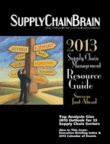
Visit Our Sponsors |
|
|
|
|
|
|
|
|
|
|
|
|
|
|
|
|
|
|
|
|
|
|
|
|
|
|
|
|
|
|
|
|
|
|
|
|
|
|

Aberdeen's "best-in-class" category are the top 20 percent of surveyed organizations on key metrics: customer service, cash conversion cycle, gross profit margin, forecast accuracy. The rationale behind using these four metrics for S&OP is that they cover the areas of service, inventory, costs and the forecast process, all of which are essential to supply chain success. We list some of the core process capabilities for S&OP below. The gaps are significant between the best-in-class and all others.
Capabilities Tell the Story
The key is to understand these differences and their impact on achieving an effective S&OP process. Best-in-class companies demonstrate greater ability to:
"¢ Evaluate unconstrained planning scenarios during supply demand balancing, 65% (best-in-class) vs. 34% (all others)
"¢ Evaluate constrained planning scenarios during supply demand balancing, 70% vs. 42%
"¢ Have systems to enable the feedback from financial planning and budgeting processes to S&OP process, 60% vs. 32%
"¢ Have systems to enable the feedback from S&OP process to the financial planning and budgeting process, 43% vs. 31%
"¢ Respond to unplanned events in a timely manner that aligns with S&OP objectives, 60% vs. 28%
"¢ Create downside risk assessment scenarios to analyze S&OP plan, 40% vs. 17%
The most fundamental issue S&OP must resolve is the demand / supply match. The first two capabilities deal with this challenge. Unconstrained planning: "How much do I need and what will it take?" Constrained planning: "What can we do with our existing resources?"
Assuming the demand / supply balance is achieved, the next question is "What is the impact on the financial plan?" First, how does the S&OP plan compare to it and secondly, is there an impact of the new plan financially? This iterative review links the operations plan and the financial plan together.
Underlying the demand / supply match is the ability to run "what if" scenarios, to allow for proper testing of the plan. Presenting the scenario results in conjunction with the recommended plan results in more rapid buy-in, because it shows all options were considered. Since the "what if" capability is in place it also makes it much easier to respond to unplanned events as they occur.
Organizationally the two key capabilities that distinguish the best-in-class from the rest are:
* Employees use exception management processes to identify and manage exceptions, 65% vs. 28%
* Sales and marketing are involved in the forecasting process at a 95% inclusion rate vs.60%
The Outlook
The capability advantage gap is so great for the best-in-class, it partially explains why there are still 56% of all others who don't have a formal S&OP process in place. It pays to move forward toward a robust S&OP process. Basics first - get planning in place for demand / supply match and formalize the S&OP process. Then, create the "what if" capabilities to enable scenario planning to establish buy-in. Finally, integrate with the financials.
Keywords: supply chain management, supply chain management IT, supply chain solutions, exception management, demand planning, forecast accuracy, S&OP, supply chain planning
RELATED CONTENT
RELATED VIDEOS
Timely, incisive articles delivered directly to your inbox.

